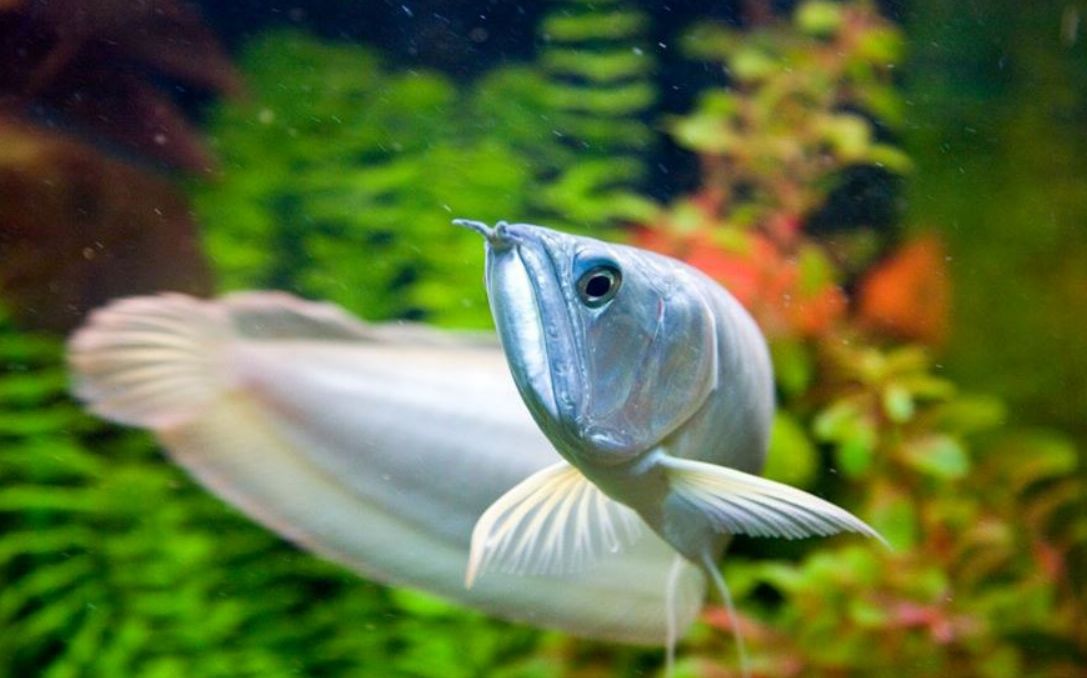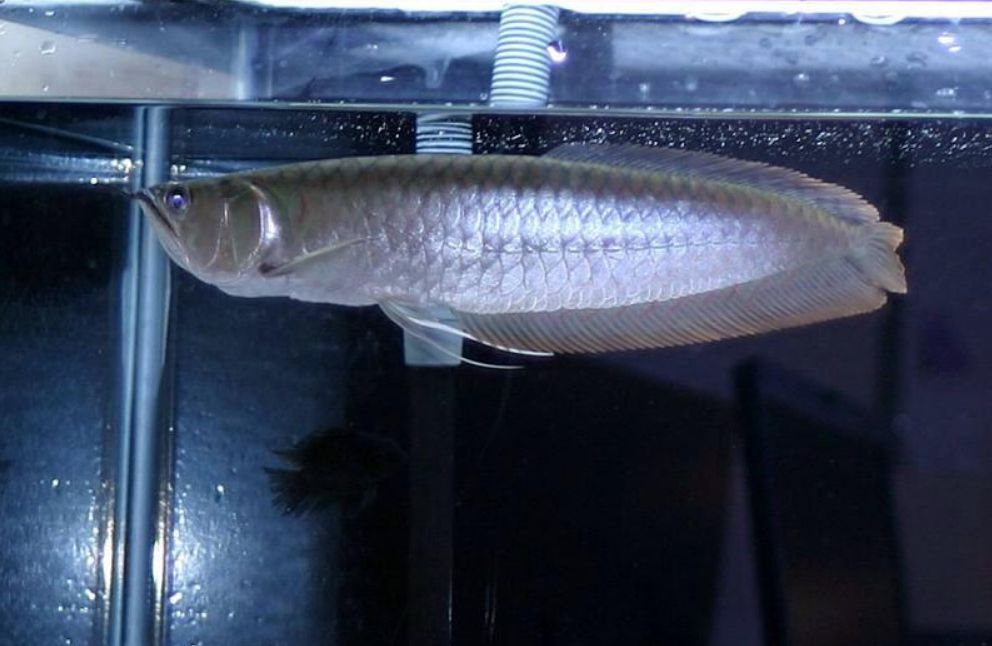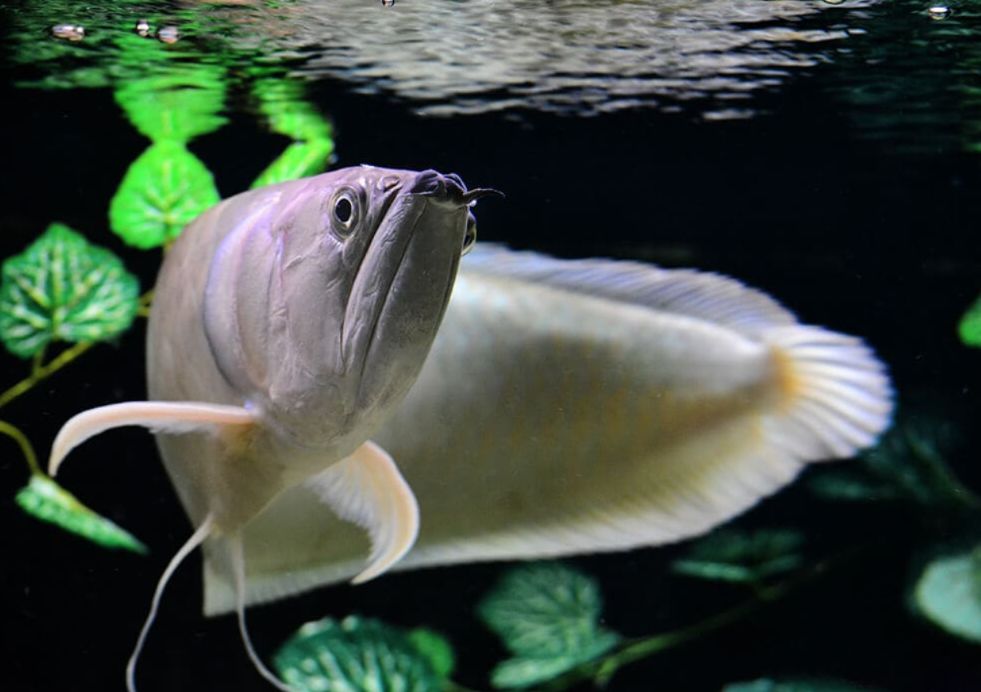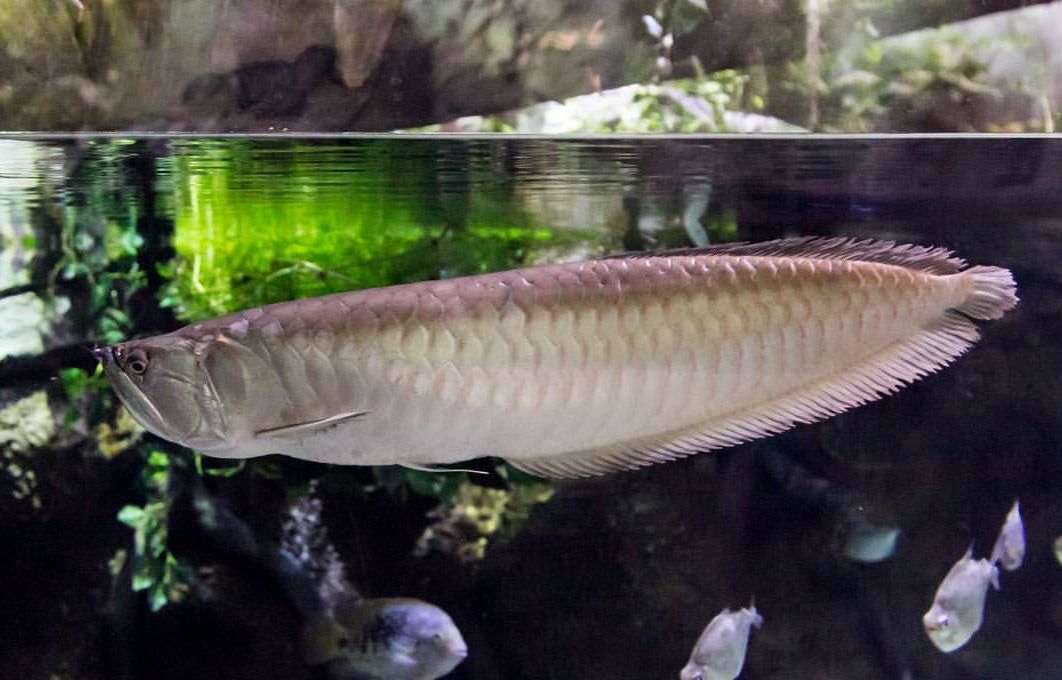The silver arowana is a tropical freshwater fish from the family Osteoglossidae, known for its ancient lineage, which dates back to the Jurassic period. Remarkably, this genus has undergone little change over the past 150 million years. Today, the silver arowana is a popular choice among aquarists and is commonly found in zoos, public aquariums, and private collections worldwide.
In many East Asian cultures, the silver arowana is considered a symbol of wealth and good fortune, often referred to as the “dragon fish” due to its majestic appearance. Some rare specimens are highly prized and can fetch prices of up to tens of thousands of dollars. Its reputation as a status symbol, along with its striking appearance, makes it a sought-after species among fish enthusiasts globally.

Contents
Habitat in the wild
The silver arowana, known scientifically as Osteoglossum bicirrhosum, is a member of the Osteoglossidae family, a group of ancient freshwater fish commonly referred to as “arowanas.” One of their defining features is a bony tongue, which is actually a hard plate on the floor of their mouth, used for crushing prey.
Representatives of the Osteoglossidae family are found across several continents, including South America, Africa, Australia, and Southeast Asia. This wide distribution is linked to the ancient origins of the family, whose predecessors lived on the supercontinent Gondwana during the Jurassic period. As Gondwana gradually split into the continents we know today, arowana species spread to different regions.
The silver arowana is native to South American river basins, including the Amazon, Orinoco, Rupununi, and Essequibo rivers. Occasionally, they have been introduced in North America, where some have been caught in ponds across different U.S. states. In the wild, silver arowanas prefer backwaters and inshore zones of rivers and lakes with water temperatures between 24-30°C. Each year, during the seasonal flooding of the Amazon, they venture into the flooded forests, where they thrive in slow-moving waters slightly away from the main current.
The silver arowana’s appearance makes it easy to identify as a surface dweller. Its superior mouth, elongated body, and the placement of its dorsal fin far back along its spine give it a distinct profile. The dorsal, anal, and tail fins form a strong paddle, enabling sudden and sharp movements when needed.
As the fish moves upstream, its body gracefully undulates side to side, while its sharp eyes remain focused on the water’s surface, alert to any disturbance. Equipped with two sensitive barbels on its chin, the arowana detects the slightest vibrations from insects or other prey that have fallen into the water. Once it locates its target, the fish leaps swiftly, opening its large jaws to capture its prey.
Known for its remarkable jumping ability, the silver arowana is often referred to as the “monkey fish” by locals. It can leap impressively high out of the water to catch insects or even small birds flying just above the surface. This unique hunting method further sets the arowana apart from many other freshwater species, both in the wild and in captivity.
Description
Size
The body of a silver arowana can reach up to 90 cm (35 in) in length, with some rare specimens growing as large as 120 cm (47 in). These fish can weigh up to 6 kg (13 lb), though they typically average around 4.6 kg (10 lb). In captivity, however, their growth can be significantly influenced by factors such as water quality, diet, and the size of their tank. To ensure healthy development and longevity, it is essential to provide a spacious aquarium with clean, well-maintained water and a diet that closely mimics their natural feeding habits.
Lifespan
The lifespan of a silver arowana depends greatly on its environment, diet, and level of care. In the wild, where they face threats from predators, diseases, and fluctuating environmental conditions, their lifespan is generally shorter, averaging around 10 to 15 years. However, in captivity, silver arowanas can live significantly longer, with some individuals reaching 20 years or more when kept in optimal conditions.
In well-maintained aquariums, where they are protected from natural hazards and given consistent care, silver arowanas have the potential for extended lifespans. To promote longevity, it’s crucial to provide them with a large aquarium that allows ample swimming space, along with clean, well-filtered water. A balanced diet that includes high-protein foods and variety, along with regular water changes and vigilant monitoring of water quality, are essential for their health. Reducing stress and avoiding common issues such as poor filtration or overcrowding are key to helping them thrive in captivity.
Body
The silver arowana has a streamlined, tape-like body that is flattened on the sides, covered in pale scales with a silvery sheen and a hint of gold. Younger fish display striking yellow-orange stripes and a bluish shimmer, which fades as they mature. Its long, narrow dorsal and anal fins almost merge with the tail, forming a powerful “paddle” alongside its wide, laterally flattened tail-stem. This unique structure enables the arowana to make sudden, swift movements, especially when hunting, and allows it to leap high out of the water. In an aquarium, a startled silver arowana can jump as high as 3 meters, so it’s important to keep a secure lid on its tank.
The fish’s dorsal fin contains about 42-50 rays, while the anal fin has 49-58 rays. Along the lateral line, it has 30-37 scales and 84-92 spinal bones. Its wide, upward-pointing mouth is equipped with two fleshy barbels that extend from the edge of its lower jaw. These barbels are highly sensitive, helping the arowana detect movement in the water as it slowly glides near the surface, often appearing as though it’s “feeling” the water with them.
A remarkable adaptation of the silver arowana is its ability to thrive in oxygen-poor waters, often staying in densely vegetated areas with low oxygen levels. To compensate, the fish has developed unique breathing adaptations. Its swim bladder is lined with a network of blood vessels, allowing it to function like a lung, absorbing oxygen into the bloodstream. Some silver arowanas have also developed an epibranchial organ, enabling them to breathe atmospheric air, which helps them survive in environments where oxygen levels are extremely low. These adaptations make them highly resilient in a variety of conditions, both in the wild and in captivity.
| Characteristic | Description |
|---|---|
| Scientific Name | Osteoglossum bicirrhosum |
| Common Name | Silver Arowana |
| Family | Osteoglossidae |
| Native Range | South America (Amazon River basin and tributaries) |
| Size | Up to 3 feet (90 cm) in length |
| Lifespan | 10-20 years (with proper care) |
| Physical Appearance | Slender, elongated body with large scales and silver coloration. The mouth has sharp teeth, and they have a long, drooping barbel on the chin. |
| Jumping Ability | Impressive jumpers; capable of leaping out of water to catch prey or escape from predators. Require a tight-fitting lid on the aquarium to prevent escape. |
| Habitat | Slow-moving or stagnant waters with dense vegetation and overhanging branches. Prefer shallow, well-vegetated areas. |
| Behavior | Predatory and carnivorous; primarily feeds on insects, crustaceans, smaller fish, and occasionally birds or mammals that fall into the water. |
| Aquarium Requirements | Need a large tank with ample swimming space; prefer dim lighting and hiding spots. Water should be kept clean and well-filtered. |
| Care Difficulty | Intermediate to advanced (due to their size, water quality requirements, and specific needs). |
| Conservation Status | Not currently listed as endangered, but their populations are threatened due to habitat destruction and overfishing. |


Difficulties in keeping
Silver arowanas are not suitable for beginner aquarists due to their size, fast growth, and demanding care requirements. Even young arowanas need plenty of space, with a minimum tank size of 250 liters (66 gallons) to accommodate their rapid growth. However, as they mature, they will require significantly larger tanks—about 800 to 1000 liters (265 gallons)—to thrive. Keeping such a large tank also means investing in a powerful filtration system to ensure clean, well-oxygenated water, as the silver arowana is sensitive to water quality.
Although they can tolerate a range of water pH and hardness levels, maintaining clean, fresh water is crucial for their health. Regular water changes and monitoring are necessary to keep the environment stable.
Feeding a silver arowana can also be quite expensive. Their diet consists of high-protein foods such as live fish, insects, and shrimp. This, combined with their large size, means they require substantial portions, making the cost of feeding significant over time. All these factors—space, equipment, and feeding costs—add up, making the silver arowana a serious long-term commitment that requires thorough preparation and experience in fishkeeping.

Care and keeping in a tank
Tank size
The most critical factor when keeping a silver arowana is ensuring it has an adequately sized tank. As large, active fish, silver arowanas require plenty of swimming space to stay healthy and reduce stress. Tank size should match the fish’s age and size, especially since they can grow up to 3 feet (90 cm) in length.
For juvenile silver arowanas (up to 15 cm or 6 inches), a 75-gallon (284-liter) tank is generally sufficient. However, as the fish grows, it will need a much larger tank. Adult silver arowanas require a tank with a minimum capacity of 250 gallons (946 liters), though some experienced aquarists recommend tanks of 500 gallons (1,892 liters) or more to allow for their active swimming and natural behavior.
To ensure the fish can move freely, the tank should be at least 160 cm (63 inches) long, 60 cm (24 inches) wide, and 50 cm (20 inches) high. Ideally, the length of the tank should be three times the length of the fish, and the width should be at least 1.2 times the fish’s length. These dimensions provide the necessary space for the fish to turn comfortably without risking injury or stress.
While juvenile arowanas can be temporarily housed in smaller tanks, they must be moved to a larger tank as they grow. Keeping them in undersized tanks can lead to body deformation and limit their lifespan. Additionally, the tank must have a secure, transparent cover, as silver arowanas are powerful jumpers. Their natural instinct to catch prey, like insects near the surface, makes them prone to leaping out of the tank. A well-secured cover helps prevent accidents and ensures the fish’s safety.
Though tank depth is not as important for silver arowanas as width and length, providing ample surface area and a secure environment is crucial to their long-term health and well-being.
Water parameters
Silver arowanas are particularly sensitive to changes in water quality, so maintaining stable parameters is key to their health. Here are the essential water conditions to ensure their well-being:
Temperature: The ideal water temperature for silver arowanas ranges from 75°F to 82°F (24°C to 28°C). It’s important to keep the temperature stable, as fluctuations can cause stress, leading to potential health problems like weakened immunity or diseases.
pH Level: A slightly acidic to neutral pH of 6.5 to 7.5 is optimal for silver arowanas. They thrive in water that mimics their natural environments, so staying within this range is crucial to avoid stressing the fish.
Ammonia and Nitrite: These compounds are toxic to fish, and levels should always remain at 0 ppm (parts per million). Even small amounts of ammonia or nitrite can be harmful, leading to gill damage, stress, or even death.
Nitrate: While nitrates are less toxic than ammonia and nitrite, keeping them low is important. Aim for nitrate levels below 20 ppm to reduce the risk of long-term health issues. Regular water changes will help manage nitrate accumulation.
Water Hardness: Silver arowanas can adapt to a range of hardness levels, but it’s best to maintain a general hardness (dGH) of 5 to 15. This range mirrors their natural habitat and ensures a balanced environment.
Water Testing: Regularly test the water using reliable test kits to monitor these parameters. This helps catch any imbalances early, preventing stress or illness.
Water Changes: Perform partial water changes of about 20-30% every one to two weeks to maintain high water quality. Silver arowanas are large fish with high waste production, making water changes critical for their health.
Filtration and Aeration: Given their size and waste output, silver arowanas require a powerful filtration system capable of handling the tank’s volume. A well-aerated environment is also essential, ensuring there’s plenty of oxygen for the fish, especially since silver arowanas prefer oxygen-rich waters. A good filtration system combined with sufficient aeration will promote a stable, healthy habitat for the fish.
Tank setup: decorations and plants
Silver arowanas are primarily surface dwellers, so they don’t interact much with the tank’s bottom or decorations. However, creating an environment that mimics their natural habitat not only enhances the aesthetic but can also contribute to their overall comfort. A typical setup for a silver arowana tank includes the following elements:
Substrate: Sand or small pebbles are commonly used as the tank substrate. These materials resemble the riverbeds of the silver arowana’s natural environment and also provide a smooth surface to prevent injury if the fish comes into contact with the bottom.
Decorations: Stones and driftwood (snags) are often added as decorations. While the silver arowana spends most of its time in the upper water layer, these elements help create a naturalistic feel, contributing to a more authentic biotope. They also provide hiding spots and break up the tank’s visual space, which can help reduce stress for the fish.
Plants: While the silver arowana is not overly concerned with plants, Vallisnéria gigantea is a good option for adding some greenery. It’s tall enough to reach the surface, matching the arowana’s swimming level. However, since silver arowanas can accidentally disturb or uproot plants, it’s a good idea to anchor them with stones to keep them secure.
Lighting: Bright lighting can stress the fish, so it’s best to opt for moderate to low-intensity lighting. Gradually increasing and decreasing the light intensity during the day helps prevent startling the fish, which can jump when frightened. This can be achieved using lighting fixtures that offer gradual dimming and brightening functions.
With these conditions in place, you can create a visually appealing and comfortable environment that keeps the silver arowana calm while allowing it to exhibit its natural behaviors.
Filtration
Here’s a detailed approach to ensuring a healthy environment:
Filtration: Silver arowanas require strong water filtration due to their size and high waste production. A canister filter is highly recommended, as it can effectively handle the volume of water and provide thorough mechanical and biological filtration.
Water Changes: Regular water renewals of 25-30% weekly are crucial to keeping water parameters stable. This practice helps dilute any harmful substances and maintains a healthy environment.
Water Quality Management: While silver arowanas can tolerate higher nitrate levels, even low concentrations of ammonia and nitrites are dangerous. Monitoring these parameters regularly is important. If detected, immediate action should be taken to correct the issue, as these toxins can severely impact fish health.
Waste Removal: Due to their high waste output, it’s essential to remove debris and uneaten food promptly. Regular tank cleaning will help prevent the buildup of organic material, which can lead to water quality issues.
Diet
Silver arowanas primarily hunt close to the water’s surface. As omnivorous fish, they primarily feed on smaller fish but also eagerly catch large insects, spiders, crabs, snails, frogs, and other small animals, including those that dwell above the water on branches and leaves. They are known for their impressive jumping ability, which allows them to snatch prey from the air.
In the wild, arowanas have been found with diverse stomach contents, including bird feathers and plant material, confirming their omnivorous diet. To replicate this in captivity, their diet should include large insects, shrimp, and small fish (no more than twice a week). Larger arowanas can also be fed small animals like mice.
Specialized food formulated for silver arowanas is also available, but it’s crucial to avoid feeding them food that sinks quickly. This practice can lead to eye issues, such as cross-eye, as the fish may begin to look down instead of scanning the water surface for prey. Over time, this can result in a condition known as drop eye.
Frogs are a favored food for many silver arowanas, and they may become so accustomed to them that they refuse other food options. Frogs can be purchased from pet shops or markets.
Feeding live small fish provides an excellent opportunity to observe the silver arowana’s hunting behavior. When choosing live prey, ensure the fish are of appropriate size for the arowana to swallow easily. Avoid any fish that are aggressive or possess sharp, poisonous spines, and ensure they are free from diseases.

Tank mates
When buying silver arowana to keep it in your tank, keep in mind that this is a predator fish. However, it does well with other tank mates if they are 3 times larger than it is.
Silver arowana can be kept together with black ghost knife fish, blood parrot, oscar fish, flowerhorn, large clown loach, black pacu, giant gourami, plecostomus). However, any smaller fishes, for example, african cichlids and goldfishes, will be treated as food. If you wanted to keep arowana and angelfishes, I wouldn’t opt for this. Arowana won’t eat large angelfishes, especially altum angelfish, but it may eat smaller ones.
There should be no more than one adult silver arowana in a tank since this fish tends to be aggressive to the species of its kind. Wild arowanas demonstrate strongly marked hierarchy when a dominating species selects and occupies a specific territory and attacks any relative that tries to come close. For this reason, adult arowanas are mostly kept alone to avoid possible conflicts between the species.

Gender differences: male vs female
Determining the gender of silver arowanas can be quite challenging, especially when they are young and not yet sexually mature. Unlike some other fish species, silver arowanas lack distinct external sexual characteristics, making visual identification difficult.
As they mature, subtle differences may become apparent, though these indicators are not reliable. For instance, males might grow slightly larger than females, but this size difference is often negligible unless multiple individuals are compared side by side.
In terms of body shape, males may appear more streamlined and elongated, while females might have a rounder belly due to egg development during breeding season. However, these distinctions are not always clear-cut.
Behaviorally, males often exhibit more territorial and aggressive tendencies during breeding, competing for female attention. Yet, this behavior alone is insufficient for accurate gender identification.
Occasionally, sexually mature females develop a small, fleshy tube known as an ovipositor near the anal area. However, spotting this feature can be challenging, and not all females will display it.
For a definitive determination of gender, internal examination methods like dissection or endoscopy would be necessary. However, these invasive techniques are not advisable for typical aquarium hobbyists and are primarily used for scientific or breeding purposes.
In summary, visually distinguishing between male and female silver arowanas is difficult, and for most aquarium enthusiasts, the sex of their arowana may remain uncertain.
Breeding
Breeding silver arowanas can be a complex yet rewarding process that requires careful preparation, an understanding of their breeding behavior, and the right environment. Here are essential points to consider if you’re interested in breeding these fish:
Age and Size: Silver arowanas usually reach sexual maturity around 3 to 4 years of age and should be at least 2 feet (approximately 60 cm) long before breeding.
Pairing: Selecting a compatible breeding pair is crucial. Introducing them while they are still juveniles allows them to form a bond as they grow. Avoid pairing aggressive individuals, as this can lead to stress or harm during breeding.
Breeding Tank: Set up a dedicated breeding tank that offers enough space for the pair to swim comfortably. Ensure excellent water quality, subdued lighting, and ample hiding spots, such as plants or PVC pipes, where the female can deposit her eggs.
Water Parameters: Maintain stable water conditions in the breeding tank. Silver arowanas prefer slightly acidic to neutral pH levels (around 6.0 to 7.5) and a water temperature of 78-82°F (25-28°C).
Conditioning: Prior to breeding, condition the pair with a varied and nutritious diet. Offering live foods like insects and small fish can stimulate breeding behavior.
Breeding Behavior: Silver arowanas exhibit mouthbrooding behavior, where the female carries the eggs and fry in her mouth until they hatch. The male typically initiates breeding by displaying courtship behaviors, circling the female and leading her to a chosen spawning site.
Egg Laying: When the female is ready to spawn, she will lay her eggs on a chosen surface, which the male fertilizes. After spawning, the female collects the fertilized eggs in her mouth for incubation.
Incubation and Fry Care: The female will hold the eggs and fry in her mouth for several weeks. Observations indicate that the male typically incubates the eggs for around 40 days. These large, red-orange eggs are rich in nutrients. During this time, the female will not eat, making a stress-free environment crucial. Once the fry are released, they will often seek protection in the female’s mouth when threatened.
Separation: Arowana juveniles hatch at approximately 3 cm in size and will continue to stay in their parents’ mouths for a while. They start venturing out as they grow, using their yolk sac as a food source until they reach about 6-7 cm. After about five weeks, the young fish will leave their parents’ mouths. Once they are swimming independently, it’s essential to separate them from the parents to prevent any aggression. Transfer the fry to a separate rearing tank and feed them suitable live or commercially available fry food.
In summary, breeding silver arowanas involves careful planning and attention to their needs throughout the process, from pairing to fry care. With the right environment and care, you can successfully nurture the next generation of these remarkable fish.